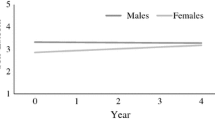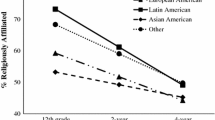Abstract
Adolescents’ religious involvement occurs within a social context, an understudied aspect of which is relationships with peers. This longitudinal study assessed changes in religiosity over 1 year and explored the extent to which these were associated with their friends’ religiosity and problem behavior. The first year sample included 1,010 (52.5% female) Muslim 13 and 15 year old Indonesian adolescents; 890 of these were assessed 1 year later. Adolescents were similar to their friends in religiosity. Changes in religiosity from year one to two were associated with friends’ religiosity such that adolescents with religious friends were more religious at year two than those with less religious friends. Reductions in religiosity were also associated with the presence of problem behavior, consistent with the inverse relationship between these. Peers may play an important role in the development of adolescent religiousness and exploring these influences deserves further study.
Similar content being viewed by others
References
Allen, J. P., & Antonishak, J. (2008). Adolescent peer influences: Beyond the dark side. In M. J. Prinstein & K. A. Dodge (Eds.), Understanding peer influence in children and adolescents (pp. 141–160). New York: Guilford Press.
Berndt, T. J., & McCandless, M. A. (2009). Methods for investigating children’s relationships with friends. In K. H. Rubin, W. M. Bukowski, & B. Laursen (Eds.), Handbook of peer interactions, relationships, and groups (pp. 63–81). New York: Guilford Publications, Inc.
Bianchi, R. R. (2004). Guests of god: Pilgrimage and politics in the Islamic world. New York: Oxford University Press.
Burkett, S. R., & Warren, B. O. (1987). Religiosity, peer associations, and adolescent marijuana use: A panel study of underlying causal structures. Criminology, 25, 109–131.
Cairns, R. B., Cairns, B. D., Neckerman, H. J., Gest, S. L. L., & Gariépy, J. L. (1988). Social networks and aggressive behavior: Peer support or peer rejection? Developmental Psychology, 24, 815–823.
Card, N. A., & Hodges, E. V. E. (2006). Shared targets for aggression by early adolescent friends. Developmental Psychology, 42, 1327–1338.
Cohen, A. B., Hall, D. E., Koenig, H. G., & Meador, K. G. (2005). Social versus individual motivation: Implications for normative definitions of religious orientation. Personality and Social Psychology Review, 9, 48–61.
Cook, T. D., Deng, Y., & Morgano, E. (2007). Friendship influences during early adolescence: The special role of friends’ grade point average. Journal of Research on Adolescence, 17, 325–356.
Davis, N. J., & Robinson, R. V. (2006). The egalitarian face of Islamic orthodoxy: Support for Islamic law and economic justice in seven Muslim-majority nations. American Sociological Review, 71, 167–190.
Desrosiers, A., Kelley, B. S., & Miller, L. (2010). Parent and peer relationships and relational spirituality in adolescents and young adults. Psychology of religion and spirituality. Advance online publication. doi:10.1037/a0020037.
Dishion, T. J., Capaldi, D., Spracklen, K. M., & Li, F. (1995). Peer ecology of male adolescent drug use. Special Issue: Developmental processes in peer relations and psychopathology. Development and Psychopathology, 7, 803–824.
Dishion, T. J., Eddy, M., Haas, E., Fuzhong, L., & Spracklen, K. (1997). Friendships and violent behavior during adolescence. Social Development, 6, 207–233.
Dishion, T. J., Piehler, T. F., & Myers, M. W. (2008). Dynamics and ecology of adolescent peer influence. In M. J. Prinstein & K. A. Dodge (Eds.), Understanding peer influence in children and adolescents (pp. 72–93). New York: Guilford Press.
Dishion, T. J., Spracklen, K. M., Andrews, D. W., & Patterson, G. R. (1996). Deviancy training in male adolescents friendships. Behavior Therapy, 27(3), 373–390.
Dishion, T. J., Véronneau, M. H., & Myers, M. H. (2010). Cascading peer dynamics underlying the progression from problem behavior to violence in early to late adolescence. Development and Psychopathology, 22, 603–619.
Eccles, J. S., Barber, B., Stone, M., & Hunt, J. (2003). Extracurricular activities and adolescent development. Journal of Social Issues, 59, 865–889. doi:10.1046/j.0022-4537.2003.00095.x.
Elliot, D. S., Huizinga, D., & Ageton, S. S. (1985). Explaining delinquency and drug use. Beverly Hills, CA: Sage.
Elliott, D. S. (1994). Longitudinal research in criminology: Promise and practice. In E. G. M. Weitekamp & H. J. Kerner (Eds.), Crossnational longitudinal research on human development and criminal behavior (pp. 189–201). Dordrecht, The Netherlands: Kluwer Academic.
Epstein, J. L. (1989). The selection of friends: Changes across the grades and in different school environments. In T. J. Berndt & G. W. Ladd (Eds.), Peer relationships in child development (pp. 158–187). New York: Wiley.
Fowler, J. W. (1981). Stages of faith: the psychology of human developmental quest for meaning. San Francisco: Harper and Row.
French, D. C., & Dishion, T. (2003). Predictors of early initiation of sexual intercourse among high-risk adolescents. Journal of Early Adolescence, 23, 295–315. doi:10.1177/0272431603254171.
French, D. C., Eisenberg, N., Vaughan, J., Purwono, U., & Suryanti, T. A. (2008). Religious involvement and social competence and adjustment of Indonesian Muslim adolescents. Developmental Psychology, 44, 597–611.
French, C. C., Purwono, U., & Rodkin, P. (2011). Religiosity of adolescents and their friends and network associates: Homophily and associations with antisocial behavior. Manuscript submitted for publication.
Glicken, J. (1987). Sundanese Islam and the value of hormot: Control, obedience, and socialization in West Java. In R. S. Kipp & S. Rogers (Eds.), Indonesian religions in transitions (pp. 238–252). Tucson: University of Arizona Press.
Gunnoe, M. L., & Moore, K. A. (2002). Predictors of religiosity among youth aged 12–22. A longitudinal study of the National Survey of Children. Journal for the Scientific Study of Religion, 41, 613–622.
Haselager, J. T., Hartup, W. W., van Lieshout, C. F. M., & Riksen-Walraven, J. M. A. (1998). Similarities between friends and non-friends in middle childhood. Child Development, 69, 1198–1208. doi:10.2307/1132369.
Hogue, A., & Steinberg, L. (1995). Homophily of internalized distress in adolescent peer groups. Developmental Psychology, 31, 897–906.
King, P. E., Furrow, J. L., & Roth, N. (2002). The influence of families and peers on adolescent religiousness. Journal of Psychology and Christianity, 231, 109–120.
King, P. E., & Roesner, R. W. (2009). Religion and spirituality in adolescent development. In R. M. Lerner & L. Steinberg (Eds.), Handbook of adolescent psychology (3rd ed., pp. 435–478). Hoboken, NJ: Wiley and Sons.
Kupersmidt, J. B., DeRossier, M., & Patterson, C. P. (1995). Similarity as the basis for children’s friendships: The roles of sociometric status, aggressive and withdrawn behavior, academic achievement, and demographic characteristics. Journal of Social and Personal Relationships, 12, 439–452.
Lippman, L. H., & Keith, J. D. (2006). The demographics of spirituality among youth: International perspectives. In E. C. Roehlkepartain, P. L. Benson, P. E. King, & L. M. Wagener (Eds.), The handbook of spiritual development in childhood and adolescence (pp. 109–123). Thousand Oaks, CA: Sage.
Newcomb, A. F., & Bagwell, C. L. (1995). Children’s friendship relations: A meta-analytic review. Psychological Bulletin, 117, 306–347.
Oser, F. K., Scarkett, W. G., & Bucher, A. (2006). Religious and spiritual development throughout the life span. In W. Damon, R. M. Lerner (Eds. in Chief) & R. M. Lerner (Vol. Ed.), Handbook of child psychology: Vol. 1. Theoretical models of human development (6th ed., pp. 942–998). New York: Wiley.
Prinstein, M. J., & Dodge, K. A. (Eds.). (2008). Understanding peer influence in children and adolescents. New York: Guilford.
Purwono, U. (2010). Assessment of religiosity of Indonesian Muslim adolescents. Unpublished manuscript. Department of Psychology, Padjadjaran University, Bandung, Indonesia.
Regnerus, M. D., Smith, C., & Smith, B. (2004). Social context in the development of adolescent religiosity. Applied Developmental Science, 8, 27–38.
Roehlkepartain, E. C., Benson, P. L., King, P. E., & Wagener, L. M. (2006). Spiritual development in childhood and adolescence: Moving to the scientific mainstream. In E. C. Roehlkepartain, P. L. Benson, P. E. King, & L. M. Wagener (Eds.), The handbook of spiritual development in childhood and adolescence (pp. 1–15). Thousand Oaks, CA: Sage.
Roff, M., & Sells, S. B. (1967). The relation between the status of the chooser and the chosen in sociometric situation at the grade school level. Psychology in the Schools, 4, 101–111.
Rubin, K., Fredstrom, B., & Bowker, J. (2008). Future directions in … Friendship in childhood and early Adolescence. Social Development, 17, 1085–1096. doi:10.1111/j.1467-9507.2007.00445.
Sallquist, J., Eisenberg, N., French, D. C., Purwono, U., & Suryanti, T. A. (2010). Indonesian adolescents’ spiritual and religious experiences and their longitudinal relations with socioemotional functioning. Developmental Psychology, 46(3), 699–716. doi:10.1037/a0018879.
Schwartz, K. D. (2006). Transformations in parent and friend faith support predicting adolescents’ religious faith. International Journal for the Psychology of Religion, 16, 311–326.
Schwartz, K. D., Bukowski, W. M., & Aoki, W. T. (2006). Mentors, friends, and gurus: Peer and non-parent influences on spiritual development. In E. C. Roehlkepartain, P. L. Benson, P. E. King, & L. M. Wagener (Eds.), The handbook of spiritual development in childhood and adolescence (pp. 109–123). Thousand Oaks, CA: Sage.
Simons, L. G., Simons, R. L., & Conger, R. D. (2004). Identifying the mechanisms whereby family religiosity influences the probability of adolescent antisocial behavior. Journal of Comparative Family Studies, 35(4), 547–563.
Smith, C., & Denton, M. L. (2005). Soul searching: The religious and spiritual lives of American teenagers. Oxford, England: Oxford University Press.
Snibbe, A. C., & Markus, H. R. (2002). The psychology of religion and the religion of psychology. Psychological Inquiry, 13, 229–234.
Stark, R. (1996). Religion as context: Hellfire and delinquency one more time. Sociology of Religion, 57, 163–173.
Thomas, D. L., & Carver, C. (1990). Religion and adolescent social competence. In T. P. Gullotta & R. Montemayor (Eds.), Developing competence in adolescence: Advances in adolescent development (pp. 195–219). Newbury Park, CA: Sage.
Vitaro, F., Brendgen, M., & Tremblay, R. E. (2000). Influence of deviant friends on delinquency: Searching for moderator variables. Journal of Abnormal Child Psychology, 28, 313–325.
Wallace, J. M., & Williams, D. R. (1997). Religion and adolescent health-compromising behavior. In J. Schulenberg, J. Maggs, & K. Hurrelmann (Eds.), Health risks and developmental transitions during adolescence (pp. 444–468). New York: Cambridge University Press.
Author information
Authors and Affiliations
Corresponding author
Rights and permissions
About this article
Cite this article
French, D.C., Purwono, U. & Triwahyuni, A. Friendship and the Religiosity of Indonesian Muslim Adolescents. J Youth Adolescence 40, 1623–1633 (2011). https://doi.org/10.1007/s10964-011-9645-7
Received:
Accepted:
Published:
Issue Date:
DOI: https://doi.org/10.1007/s10964-011-9645-7




